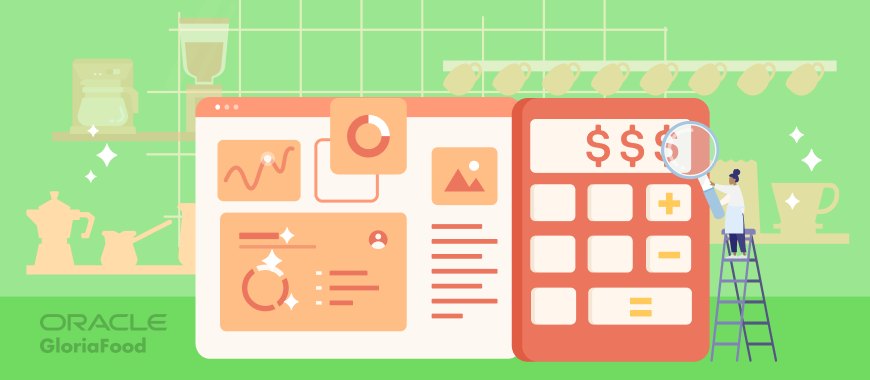- 1.What are financial ratios for restaurants?
- 2.Why it’s important to measure financial ratios for restaurants?
- 3.The most important financial ratios every restaurant should monitor
- Gross Profit Margin
- Net Profit Margin
- Breakeven Point
- Average Revenue Per Customer
- Food Cost Percentage
- Inventory Turnover
- Table Turnover Rate
- Restaurant Labor Cost Percentage
- Restaurant employee turnover rate
- 4.The checkout
Serving delicious meals is only one aspect of running a great restaurant; another is knowing how well your business is doing. Financial ratios for restaurants assist managers and owners in monitoring their progress and identifying areas for development. By keeping an eye on the appropriate financial ratios, you can guarantee long-term success in the restaurant industry, smooth out operations, and make better decisions.
What are financial ratios for restaurants?
Financial ratios are quantifiable indicators that assess how well a company is doing at accomplishing its goals. Financial ratios for restaurants include a broad range of topics, including financial success, customer satisfaction, sales, and operational effectiveness. These financial ratios provide information about the efficiency of the restaurant’s operations and assist owners in: –
- Recognizing patterns
- Identifying problems
- Capitalizing on opportunities.
Why it’s important to measure financial ratios for restaurants.
As a business owner the more you understand your restaurant’s current performance, the better chances of success will be. By setting long-term goals and continually monitoring financial ratios you can gain important insights into your restaurant’s strengths and areas that require improvement. Financial ratios for restaurants are important to measure because they:
- Optimize Operations
- Improve Profitability
- Enhance Customer Satisfaction
- Drive Growth
Tracking financial ratios doesn’t have to be difficult. Many of today’s point-of-sale (POS) systems, online ordering systems, and restaurant management software come with built-in KPI tracking features. These systems automatically gather and analyze data, allowing you to make data-driven decisions in real-time.
The most important financial ratios every restaurant should monitor
Before we begin to list the most important financial ratios to track, we must go back to Restaurant Accounting 101 to understand some fundamental terms.
Total revenue – This is the sum of money your restaurant brings in over a given time frame. It gives you an insightful snapshot of your total performance.
Gross Profit – This is the funds that are left over after your restaurant deducts the costs associated with making and selling its meals.
Cost of Goods Sold (COGS) – This is defined as the direct costs associated with the production of the meals sold by your restaurant.
Net Profit -This is your restaurant’s total earnings after subtracting all expenses.
Now that we have a grasp on the building blocks for any financial ratio we can begin listing these ratios.
Gross Profit Margin
This shows how well your restaurant is doing in terms of sales; more precisely, it shows what proportion of revenues remain after deducting the cost of goods sold (COGS). This restaurant’s financial ratio is important because it demonstrates whether a restaurant’s sales are enough to cover its cost.
Formula
Net Profit Margin
This shows how much “profit” you get to keep after all expenses have been deducted. This restaurant financial ratio takes into consideration not only operational expenses but also your indirect/overhead expenses like electricity and phone bills.
Formula
(Net Profit / Total Revenue) * 100
Breakeven Point
Simply put, this metric measures the point at which your total expenses and total revenue are equal. This means that your restaurant is neither losing nor gaining additional funds. Understanding your break-even point will help you make plans for the future and give you a better understanding of your restaurant’s financial situation.
Formula
Average Revenue Per Customer
This ratio measures the average amount of money you make per customer; this metric is also often referred to as the “average check size.” It is important to keep track of the average amount of money made by every client. This can assist you in gaining insight into the impact of upselling and pricing strategies.
Formula
Food Cost Percentage
This measures the cost of ingredients as a percentage of total food sales, making it one of the most important KPIs in the restaurant industry. Industry standards state that the average food cost percentage falls between 28% and 35%. It is important to keep your food cost percentage in mind when pricing menu items. This way, each dish accounts for the cost of its materials and leaves a sufficient margin for other overhead expenditures and profit.
Formula
Inventory Turnover
This KPI calculates the frequency of usage and replacement of your inventory over time. A low turnover rate could be a sign of inefficiency or overstocking. To avoid overstocking or under-stocking your shelves, you must monitor the frequency with which you use your complete inventory. Overstocking can lead to a waste of food and money while understocking can lead to several menu items being unavailable from your menu.
Formula
Table Turnover Rate
This restaurant KPI measures the number of times a table is occupied by various customers over the course of a particular period. A quick turnover translates into more money in your pocket because you can serve more guests. Monitoring this metric will enable you to estimate the number of employees you’ll require at different times, enabling you to staff your restaurant more efficiently.
Formula
Restaurant Labor Cost Percentage
This financial ratio calculates the portion of your revenue that goes towards paying employees’ salaries, wages, and benefits. You’ll be more equipped to handle any challenges that come your way if you know how much you spend on staffing and how those expenses connect to your sales. The industry standard for this metric is between 25% to 35%.
Formula
Restaurant employee turnover rate
This metric measures the number of employees who leave their jobs over a certain period of time. Restaurant employee turnover rates tend to be some of the highest when compared to other industries. This can prove problematic for you considering the number of resources that are required to get an employee ready for the task they were hired. The average restaurant employee turnover rate is 79.6% over the past 10 years. Learning how to manage restaurant staff well can reduce this number significantly.
Formula
The checkout
Understanding and tracking restaurant metrics is important for the long-term success of your business. You can increase your profitability and make well-informed decisions while maintaining your competitive edge in the restaurant industry.










